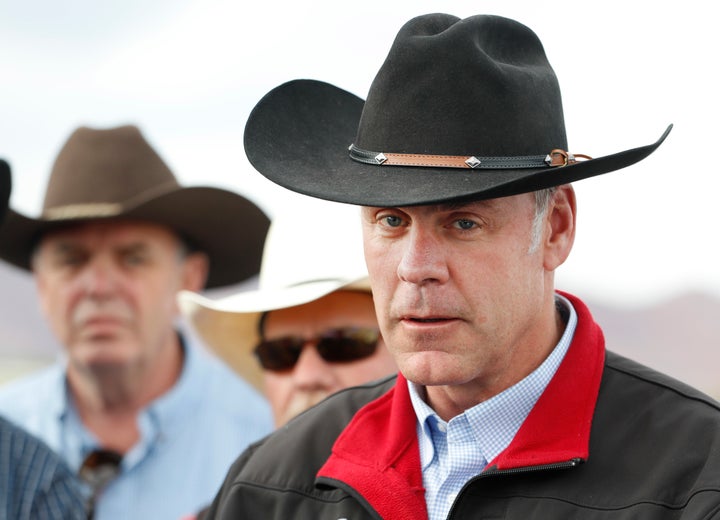Ryan Zinke’s Official Portrait A Final Slap In The Face To Native American Tribes
When then-Interior Secretary Ryan Zinke traveled to southern Utah in May 2017 to visit a pair of protected national monuments, he surrounded himself with advocates for dismantling, if not entirely erasing, those sites.
He toured Bears Ears National Monument not with members of the Native American tribes that consider the landscape sacred, but staunch opponents of the Obama-era monument. He gave representatives of the Bears Ears Inter-Tribal Coalition, made up of the five tribes that petitioned for the monument’s designation, just a one-hour meeting. And when an indigenous woman confronted Zinke about why he hadn’t spent more time talking with tribal leaders as part of his review, he shook his finger in her face and forcefully ordered her to “be nice” and “don’t be rude.”
True to form, Zinke commemorated his scandal-plagued tenure atop the federal agency this week with a portrait of himself riding a paint horse beneath a towering butte in Bears Ears shortly before he and President Donald Trump gutted protections. It is based on a picture of Zinke during his 2017 visit and was unveiled during a ceremony Wednesday at the Interior Department headquarters in Washington, D.C. Attendees, including Zinke’s wife and former Navy intelligence officer Donald Bramer, posted pictures of the event to social media.
(We’ll get to that fiery snake battle pic in a minute.)
Zinke was secretary of Interior from 2017 to late 2019, when he resigned under a cloud of ethics scandals. His replacement, David Bernrhardt, is a former oil, mining and agricultural lobbyist who has furthered the administration’s assault on environmental rules.
Named after a pair of buttes and home to thousands of Native American archeological and cultural sites, Bears Ears was the first monument established at the request of tribes to honor and protect Native American heritage. In December 2017, on Zinke’s recommendation, Trump shrunk the 1.35 million-acre Bears Ears boundary by 85% and the nearby 1.87 million-acre Grand Staircase-Escalante National Monument roughly in half, opening the door for oil, gas and other development across large areas of previously protected lands.
Brent Cotton, the Montana artist and “dear friend” of the Zinke family who painted the portrait, told Billings radio station KBUL that the piece includes “a nod to [Zinke’s] respect of the native Americans tribes” (sic) in the band of the hat. (Aaron Weiss of the Center for Western Priorities pointed out the hat appears to be on backwards ― something Zinke famously did in real life.)
Zinke’s supposed respect for tribes was no doubt lost on the tribes that pleaded with him to leave Bears Ears alone. When Zinke recommended in July 2017 that Trump dismantle the monument, the Bears Ears Inter-Tribal Coalition condemned it as a “slap in the face to the members of our Tribes and an affront to Indian people all across the country.” And when Trump followed through and signed a proclamation to shrink the site, Ethel Branch, the attorney general for the Navajo Nation, slammed the move as “absolutely shocking” and totally “disrespectful” of the decades of work that went into establishing Bears Ears.
In many ways, the portrait perfectly captures what is widely seen as Zinke’s most controversial action and his lasting legacy: rolling back public land and environmental protections to the benefit of extractive industries and undermining tribal sovereignty.
In his statement to KBUL, Cotton said he hoped the portrait “will be well received by all.”
Not surprisingly, the response has been anything but positive.
In a scathing statement Tuesday, Rep. Raúl Grijalva (D-Ariz.), chairman of the House Natural Resources Committee, called the portrait “a petty monument to a petty man,” “an intentional final insult to tribes he disrespected” and “entirely consistent with his smug, unethical, condescending tenure” at the agency.
Patrick Gonzales Rogers, executive director of the Bears Ears Inter-Tribal Coalition, told HuffPost via email that “the image speaks for itself.”

In addition to the official portrait that will join those of other former agency secretaries displayed at Interior headquarters, Wednesday’s event included the unveiling of a second unofficial one depicting Zinke once again atop a horse and wearing a cowboy hat, but this time riding through flames, wielding a battle ax and fighting a massive serpent. That prank piece, simply Zinke’s face pasted onto fantasy artist Frank Frazetta painting titled “Death Dealer 6,” appears to be a reference to the Trump administration’s pledge to “drain the swamp” of lobbyists in Washington ― something that absolutely did not happen at Interior under Zinke’s watch.
After resigning from the Interior post, Zinke quickly found work with a blockchain investment firm, a lobbying group and a mining exploration company. Numerous other officials at Trump’s Interior Department have similarly stepped through the revolving door, landing jobs with fossil fuel interests, lobbying firms or other private companies after leaving the agency, as HuffPost previously reported.
While Zinke fancies himself a rugged cowboy and Rooseveltian conservationist, he is likely to be remembered not as a steward of America’s natural resources but a loyal strongman for Trump’s “energy dominance” agenda who racked up nearly 20 federal investigations during his stint as Interior chief. As for the rollbacks of protected wild places that he is so clearly proud of, they appear unlikely to survive the incoming Biden administration.
President-elect Joe Biden and Vice President-elect Kamala Harris have vowed to “take immediate steps to reverse the Trump administration’s assaults on America’s natural treasures, including by reversing Trump’s attacks on the Arctic National Wildlife Refuge, Bears Ears, and Grand Staircase-Escalante,” as well as establish new protected sites to safeguard ecologically rich landscapes and combat global climate change.
RELATED…
Source: Read Full Article

